Atlas 25,500 Gallon Tank Car
Published: 2021-12-31 - By: CNW400
Last updated on: 2022-01-01
Last updated on: 2022-01-01
visibility: Public - Headline
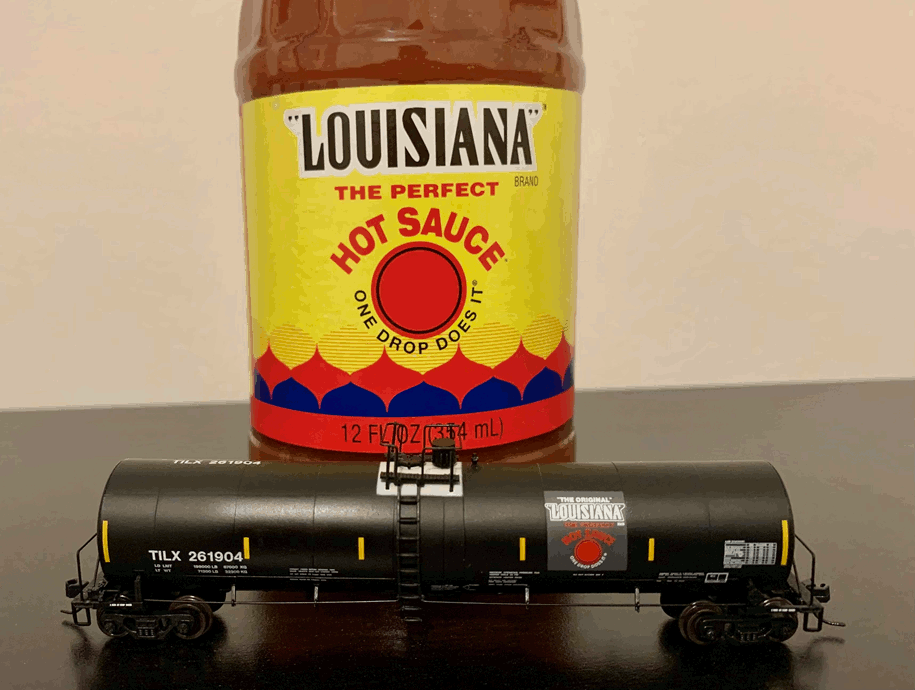
In the summer of 2021, Atlas Model Railroad expanded their Master Line 25,500-gallon tank car collection with two new paint schemes. The Master Line Series offers greater attention to detail and frequently includes separately attached metal and plastic parts. First issued in 2009 by Atlas, this current assortment of 25,500-gallon tank cars includes three unusual and fun hobby pieces.
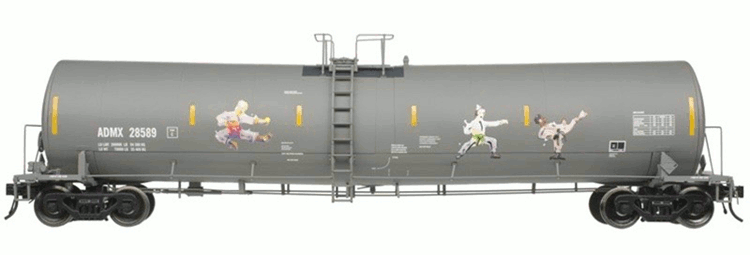
A replica of a real tank car spotted near a salad dressing factory in Hillside, NJ by Atlas staff
The suggested retail price is $36.95. My review includes observations of Atlas stock number: 50 005 687 – TrinityRail (TILX) #261904.
The basic tank had a handrail that ran horizontal around the entire car, running boards, a ladder to access the dome hatch (called a manway) and end sills. Common sizes for tank cars pre-World War II were 8,000 – 12,000 gallons (about twice the volume of a large U-Haul truck). The size tank was dependent on the load size requested by the customer and the load weight of products - thus a variety of designs were created. Sulfuric acid and chlorine are heavy commodities, thus demanding a smaller tank car. Gasoline and propane are lighter products and can be transported in larger tanks.
Non-pressure cars can be unloaded from a top or bottom outlet. A hose or threaded pipe is connected to an unloading valve. Pressure cars are unloaded from outlet connections located in a housing on top of the tank. Non-pressurized cars were insulated with either cork or foam and covered with thin steel sheathing. These cars could also be equipped with steam heating coils to assist viscous liquids, such as tar or corn syrup, flow more freely during unloading. Pressurized cars were insulated with external steel sheathing and do not have heating systems.
The most common color from tank cars is black. In theory, it hides the stains and spillage of most commodities. Tank cars hauling hazardous materials had four HAZMAT placards: one on both sides of the car and one on each end. The placard color is based on the material being transported and if it is flammable, corrosive, reactive or an inhalation hazard. Empty tanks have no placards posted. The yellow conspicuity stripes are situated on tank cars to reflect the headlights from an on-coming vehicle. The ARR mandated that all in service rolling stock have reflective markings by January 1,2014. Furthermore, cars needed to be stenciled with the lading being transported.
While I have explored the history of tank cars more thoroughly in previous reviews – this time I wish to answer the questions of who came up with these rules and what is with all that writing on the tank car?
While industry trade groups did not mandate a standard design for tank cars, the railroads have issued a manual of standards and recommend practices for tank cars for over one-hundred years. The Master Car Builders Association drafted the first report of specifications for transporting hazardous materials via tank cars in 1903. Those recommendations were revised and reissued by the American Railway Association in 1925 and adopted by the Association of American Railroads (AAR) in 1931.
Furthermore, the Interstate Commerce Commission (ICC) in 1927 issued federal regulations for articles classified as dangerous. The Interstate Commerce Commission was signed into law by President Grover Cleveland in 1887 with the main purpose to regulate American railroads.
After the passage of the Department of Transportation Act in 1966 these rules fell under the authority of the DOT (Department of Transportation) Hazardous Materials Regulations effective April 1967. The United States Department of Transportation (USDOT or DOT) is a federal department of the government regulating transportation matters. The department's mission is "to develop and coordinate policies that will provide an efficient and economical national transportation system, with due regard for need, the environment, and the national defense." The ICC was abolished with the Termination Act of 1995 with all railroad affairs transferred to the newly formed U.S. Surface Transportation Board (STB).
This recent Atlas Model Railroad release is patterned after the TrinityRail 25,500-gallon tank car. The insulated and coiled general service railcar with first produced by Trinity Industries of Dallas, Texas in 1986. The 56-foot-long tank car is used to haul such commodities as corn syrup, molten sulfur, crude oil, latex, wine, glycerol, and other food products including vegetable oil and other liquid ingredients.
Trinity Industries manufactures railcars (hopper cars, gondolas, flat cars, roll cars, intermodal cars, and tank cars) and component parts. The company also provides fleet management, maintenance, and leasing services.
Trinity Industries was founded in 1933 by C.J. Bender as Trinity Steel, first producing butane tanks then petroleum tanks and steel fabrication for the oil refineries. In 1966 Trinity began to manufacture tank car bodies for Richmond Tank Car and Union Tank Car. Later in 1978, Trinity Steel changed its name to Trinity Industries and produced covered hoppers and tank cars in association with Quick Car. In 1984 Trinity acquired Quick Car and the production designs & facilities of the Pullman-Standard Car Company. Also, in 1984 Trinity Industries acquired the designs of the General American Transportation Company.
Continuing their conquest of the railcar industry, Trinity Industries in 1986-1987 acquired the railcar designs of North American Car Corporation, Ortner Freight Car, and auto-rack builder Portec-Paragon. The company further purchased the designs and production facilities of the Greenville Steel Car Company. These acquisitions made Trinity Industries the largest railcar manufacturer in North America. Finally in 2001, Trinity Industries acquired the designs and facilities of the second largest North American railcar manufacturer – the Thrall Car Company.
Trinity Industries railcar branch – TrinityRail – manufactures over 270 different railcar designs. Furthermore, Trinity’s Highway Products line offers a wide range of roadway equipment including highway guardrails, crash cushions and traffic control barriers.
Starting on the far left of the tank in large characters we find TILX 261904.
TILX is called the reporting mark – a two to four letter code used to identify owners or lessees of rolling stock. Reporting marks may include any letter of the alphabet and those marks ending in ‘X’ indicate private company ownership as opposed to a railroad. A letter sequence may only be used for one registered owner or lessee. Official Association of American Railroads (AAR) reporting marks do not include the ampersand, although stenciled on rolling stock for clarity. If retired or left abandoned for five years, a letter set can be reassigned. TILX = TRINITY INDUSTRIES LEASING CO. 261904 or the road number is the assigned identifier in an owner’s fleet. Road numbers may be up to six digits in length.
The reporting mark and road number is also located on the top of the tank for crewmembers working on platforms above the railcar.
LD LMT or Load Limit is the weight limit of cargo that can be loaded onto or into the railcar. Number is given in both U.S. pounds and the International System of Units, metric system kilogram since rolling stock also travels into Mexico and Canada.
LT WT or Light Weight is the weight of the empty railcar. Again, reported in U.S. pounds and kilograms. Finally on the edge of the platform above the wheels is stenciled ‘2 Inch HF Comp Shoes’. This indicates the type of brake shoes equipped on the tank car. This tank car has a 2-inch width High Friction Composition Brake Shoe. Cast iron brake shoes had been used in the past.
As we move along the tank car the small printing to the left of the ladder reads:
Consult Owner Before Repairing Tank - This directive follows then AAR Manual of Standards Sec. 1.3.6. In part it states: 1.3.6.1 “Design and materials for fabrication, alteration, conversion, or welded repairs must be approved...” and 1.3.6.4 “Replacement of an AAR-approved valve or closure with another AAR-approved valve or closure requires car owner approval.”
Lines 2-4 read: Sharp Objects Must Not Contact Lining Do Not Steam or Clean Tank With Boiling Water or Caustic Soda
Found stenciled to the immediate left of the ladder near the bottom of the tank is the word Inlet and to the right Outlet.
Continuing to the right of the ladder on only one side of the tank we see the instructions: Handle Must Be Locked and Chained in Closed Position Before Loading – the other side of the tank does not have this instruction but instead the data report: 4” Fiberglass Insulation
Next to that are the directives: Maximum Operating Pressure for Heater Coils: 25 PSI Exterior Heater Pipes No Inlet or Outlet Pipe Caps Required Vent Tank When Unloading
Underneath the Louisiana Hot Sauce logo, we find the warning: Do Not Exceed 450◦ F.
The last set of lettering before the boxes reads:
Ownership Subject to a Security Agreement Filed with the Surface Transportation Board - Federal law states that any mortgages, leases, or security agreements relating to rolling stock must be filed with the STB. The Surface Transportation Board must also be notified of any assignments, amendments, or releases.
Below that we see the tank car Paint Code and the Built Date and shop identification: TXIX 02/2009
The smaller box is called the Consolidated Stencil and lists the types of air brake valves used (DB-10 and DB-20) and the car-built date BLT 02-2009.
The larger rectangle is the Qualification Panel listing the AAR tank car designation above the box: AAR 211A100W1.
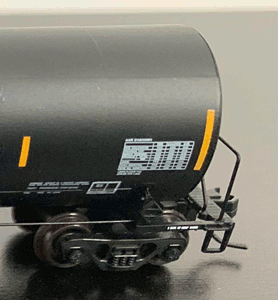
Location of Consolidated Stencil and Qualification Panel
The Class 211A tank car designation (Tank Car, General Service, Carbon Steel Tank, Welded or Riveted, Rubber Lining Optional) was originally approved by the American Association of Railroads on November 10, 1966, and further revised in 1971.
AAR: Authorizing Agency (Association of American Railroads)
211: Car Class (Tank Car, General Service, Carbon Steel Tank, Welded or Riveted, Rubber Lining Optional)
A: Equipped with top and bottom shelf couplers. All hazardous material cars must be equipped with couplers having top and bottom shelves. The purpose is to prevent vertical coupler disengagement during derailment and minimizing the potential for tank shell puncture.
100: Tank Test Pressure – Maximum Designed Pressure
W1: Welded, Carbon Steel Tank, 2% Minimum Expansion Capacity, Optional Bottom Outlet or Washout
 The following rows on the Qualification Panel list the required certification tests for the tank car, where the inspection was performed, when inspection was completed and when the next inspection is due.
The following rows on the Qualification Panel list the required certification tests for the tank car, where the inspection was performed, when inspection was completed and when the next inspection is due.
 PRD: Pressure Relief Device – Lets responding emergency personnel know the PRD is a valve and what pressure the vale will open-up to release excess pressure that built-up inside the tank (NOTE: I could read the exact PSI number printed on the model).
PRD: Pressure Relief Device – Lets responding emergency personnel know the PRD is a valve and what pressure the vale will open-up to release excess pressure that built-up inside the tank (NOTE: I could read the exact PSI number printed on the model).
An 88.B.2 Inspection verify the results of mechanical inspection made to determine if the subject railcar meets the minimum mechanical requirements for interchange use of freight cars.
A Stub Still design supports each end of the tank over the trucks and provides a housing for the car-to-car connections.
Plasite Lining is produced by Carboline and is a solvent-free and BPA-free, flexible epoxy lining specifically developed for tank cars that transport liquid food products. It is chemical resistance in caustic, acid, and solvent service.
Tank cars are required to be inspected every ten years and certification of the testing must be filed with the railcar owner’s Logistics Department and results presented when requested. The AAR does not mandate a ‘life limit’ on a tank car if the railcar conforms to current regulations and requirements. Since July 1, 1974, the AAR has applied a ‘life limit’ of 50-years for underframes on a tank car. After applying the new underframe, the tank car must be requalified to verify its integrity (AAR Manual of Standards Sec. 1.3.10).
Lasty, the heads (ends) of the tank cars also include some stenciling...
The Reporting Mark and Road Number both again are represented in large characters with the tank capacity THIS TIME reported in U.S. gallons and the metric Liter.

Car End Detail
The bottom four lines report the type of equipment affixed to the railcar:
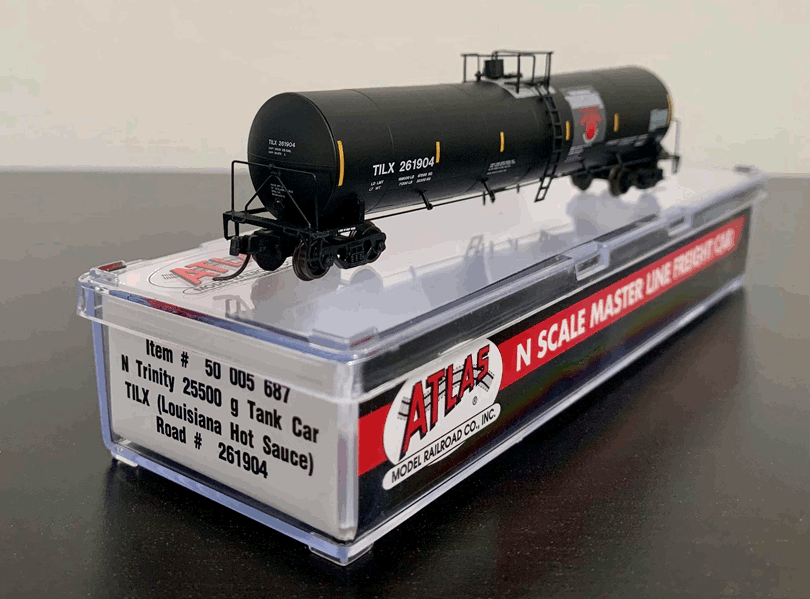
Model with acrylic box
The ready-to-run tank car came packaged in a clear plastic jewel case with a slip-off cover and a two-piece plastic cradle to cushion the model. The model information is clearly labeled on the end of the case for ease to locate when in storage. A thin plastic film was wrapped around the car to protect the car from scuffmarks and scratches. No additional detail pieces were found in the packaging.
The Trinity tank car’s black paint job is clean and even along the entire injection molded plastic model. The underframe and all piping & rails are also black. Lettering is extremely sharp and clear, even when magnification is needed for the smaller printing. The font, size, and placement of all lettering on the Atlas model is identical to prototype images found of tank car TILX #261905. The Atlas model even features the prototype correct six yellow conspicuity stripes on each side of the tank shell. The sides also feature safety bars (very fragile), center ladders to manway platform, stirrup steps and empty hazmat placard holders.

Side View
Hazmat placards are not displayed on the model or the prototype since vinegar is not considered a hazardous material. The Department of Transportation (DOT) does publish an Emergency Response Guidebook and free phone app (ERG 2020) listing the names of hazardous cargo and the proper response procedures in case of an accident. Hazards and placards are categorized by number (large number in center of placard), symbol, color, and code (small number in lower corner). Railfans can decipher what type of hazardous material is being hauled in a tank car by simply looking-up the hazard number printed on the center of the card.
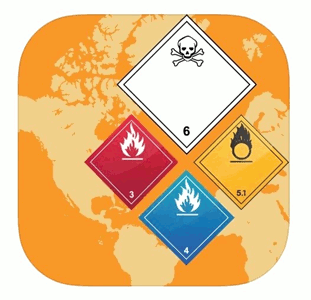
Department of Transportation Hazmat Guidebook App (ERG 2020)
The only complaint for the prototype correct hobbyist would be the grey background used on the Atlas model for the hot sauce logo is not found on any prototype images I have viewed. The real-life tank cars have the Louisiana Hot Sauce logo applied to a black semi-gloss backing, not the bright grey found on the Atlas tank cars.
The tank heads display the road marking, car number and capacity in gallons and liters. Both ends also feature a hazmat placard holder, hand railings, solid plastic (not see-thru) platforms, and grab irons. The B-end features a separately hand brake that is mounted the proper height when compared to the prototype.
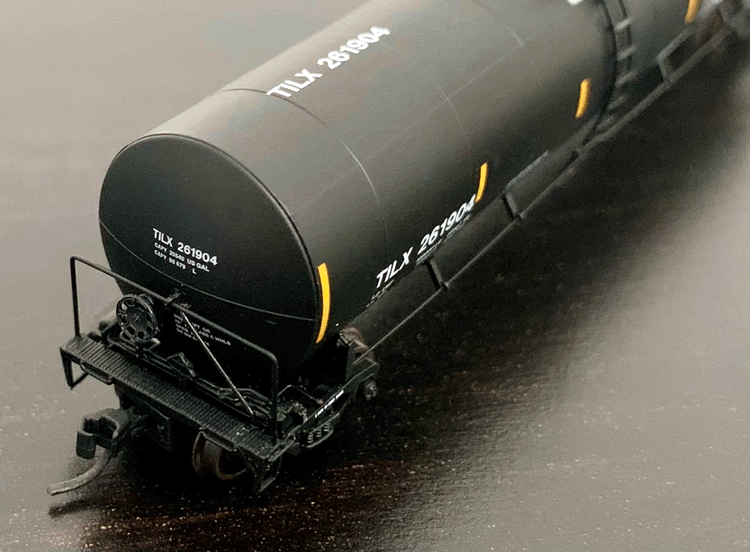
Head End Detail
The black underside has an elaborate arrangement with highly detailed separately applied and molded details including the break beam, brake rods, slack adjuster, brake cylinder and brake lever. The tank car rides along brown plastic wheels and is equipped with truck mounted AccuMate magnetic couplers. Both couplers were mounted to the proper height.
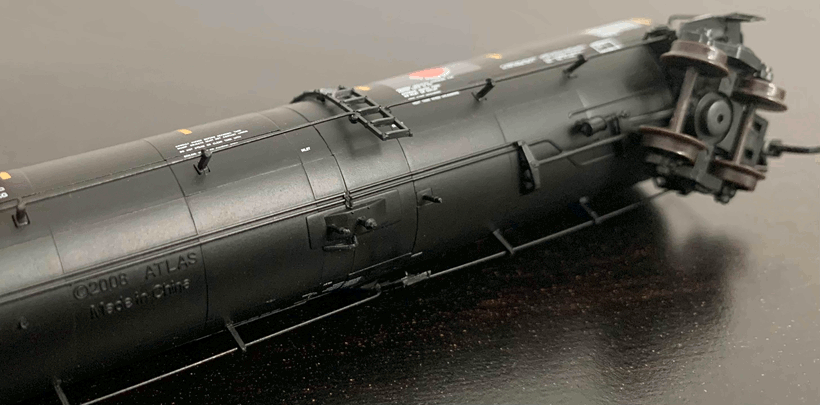
Highly Detailed Underside with Outlet Valve & Skid Plate
(center) and All the Correct Brake System Parts
The underside also features the bottom outlet valve and handle. The outlet valve is protected with a molded skid plate to protect the valve from damage or unintentionally opening during an accident or derailment.
The top of the tank correctly represents a domeless steel car with a ladder leading to a two-piece see- thru platform with handrails in the proper configuration when compared to prototype images. The platform pieces on my model were a little warped. Featured are the Protective Valve Housing (the taller piece which covers the loading/unloading valve and vapor release valve), the Manway cover (flat lid that allows access to the inside of the tank) and Pressure Release Valve (skinny black piece located next to the platform). Great detail for a N Scale model. The square grey protective coating around the platform, although a tad too bright, is prototypical in color and usage.

Left to Right (Manway Cover, Protective Valve Housing & Pressure Release Valve)
The car is 4 1/4 inches in length and weighs 1.1 ounces, which is perfect according to the National Model Railroad Association (NMRA) recommendations (which are 1.1 - 1.2 ounces for this size car). I found it a great runner while testing the car on Kato Unitrack with no issues around curves or through turnouts at slow and medium speeds. In the future I will upgrade the brown plastic wheel sets to black metal wheels.
To see a list of all cars in this series, CLICK HERE.
Road Names and Pricing
This Master Line release includes two different paint schemes. The road names represented in this collection include:- ADMX #28589 – TrinityRail Kung-Fu Graffiti (50 005 686)
- TILX #261904 – TrinityRail Louisiana Hot Sauce (50 005 687)
- TILX #261906 – TrinityRail Louisiana Hot Sauce (50 005 688)

The suggested retail price is $36.95. My review includes observations of Atlas stock number: 50 005 687 – TrinityRail (TILX) #261904.
Prototype History
Tank cars were one of the first all-steel pieces of rolling stock – originating from the Pennsylvania crude oil fields in the late 1860’s. Merely tanks mounted onto flatcars to transport oil evolved into the basic design of a riveted or welded horizontal tubular- shaped tank riding on a separate steel underframe, sitting in a saddle and anchored to the frame with a series of narrow bands.The basic tank had a handrail that ran horizontal around the entire car, running boards, a ladder to access the dome hatch (called a manway) and end sills. Common sizes for tank cars pre-World War II were 8,000 – 12,000 gallons (about twice the volume of a large U-Haul truck). The size tank was dependent on the load size requested by the customer and the load weight of products - thus a variety of designs were created. Sulfuric acid and chlorine are heavy commodities, thus demanding a smaller tank car. Gasoline and propane are lighter products and can be transported in larger tanks.
Non-pressure cars can be unloaded from a top or bottom outlet. A hose or threaded pipe is connected to an unloading valve. Pressure cars are unloaded from outlet connections located in a housing on top of the tank. Non-pressurized cars were insulated with either cork or foam and covered with thin steel sheathing. These cars could also be equipped with steam heating coils to assist viscous liquids, such as tar or corn syrup, flow more freely during unloading. Pressurized cars were insulated with external steel sheathing and do not have heating systems.
The most common color from tank cars is black. In theory, it hides the stains and spillage of most commodities. Tank cars hauling hazardous materials had four HAZMAT placards: one on both sides of the car and one on each end. The placard color is based on the material being transported and if it is flammable, corrosive, reactive or an inhalation hazard. Empty tanks have no placards posted. The yellow conspicuity stripes are situated on tank cars to reflect the headlights from an on-coming vehicle. The ARR mandated that all in service rolling stock have reflective markings by January 1,2014. Furthermore, cars needed to be stenciled with the lading being transported.
While I have explored the history of tank cars more thoroughly in previous reviews – this time I wish to answer the questions of who came up with these rules and what is with all that writing on the tank car?
While industry trade groups did not mandate a standard design for tank cars, the railroads have issued a manual of standards and recommend practices for tank cars for over one-hundred years. The Master Car Builders Association drafted the first report of specifications for transporting hazardous materials via tank cars in 1903. Those recommendations were revised and reissued by the American Railway Association in 1925 and adopted by the Association of American Railroads (AAR) in 1931.
Furthermore, the Interstate Commerce Commission (ICC) in 1927 issued federal regulations for articles classified as dangerous. The Interstate Commerce Commission was signed into law by President Grover Cleveland in 1887 with the main purpose to regulate American railroads.
After the passage of the Department of Transportation Act in 1966 these rules fell under the authority of the DOT (Department of Transportation) Hazardous Materials Regulations effective April 1967. The United States Department of Transportation (USDOT or DOT) is a federal department of the government regulating transportation matters. The department's mission is "to develop and coordinate policies that will provide an efficient and economical national transportation system, with due regard for need, the environment, and the national defense." The ICC was abolished with the Termination Act of 1995 with all railroad affairs transferred to the newly formed U.S. Surface Transportation Board (STB).
This recent Atlas Model Railroad release is patterned after the TrinityRail 25,500-gallon tank car. The insulated and coiled general service railcar with first produced by Trinity Industries of Dallas, Texas in 1986. The 56-foot-long tank car is used to haul such commodities as corn syrup, molten sulfur, crude oil, latex, wine, glycerol, and other food products including vegetable oil and other liquid ingredients.
Trinity Industries manufactures railcars (hopper cars, gondolas, flat cars, roll cars, intermodal cars, and tank cars) and component parts. The company also provides fleet management, maintenance, and leasing services.
Trinity Industries was founded in 1933 by C.J. Bender as Trinity Steel, first producing butane tanks then petroleum tanks and steel fabrication for the oil refineries. In 1966 Trinity began to manufacture tank car bodies for Richmond Tank Car and Union Tank Car. Later in 1978, Trinity Steel changed its name to Trinity Industries and produced covered hoppers and tank cars in association with Quick Car. In 1984 Trinity acquired Quick Car and the production designs & facilities of the Pullman-Standard Car Company. Also, in 1984 Trinity Industries acquired the designs of the General American Transportation Company.
Continuing their conquest of the railcar industry, Trinity Industries in 1986-1987 acquired the railcar designs of North American Car Corporation, Ortner Freight Car, and auto-rack builder Portec-Paragon. The company further purchased the designs and production facilities of the Greenville Steel Car Company. These acquisitions made Trinity Industries the largest railcar manufacturer in North America. Finally in 2001, Trinity Industries acquired the designs and facilities of the second largest North American railcar manufacturer – the Thrall Car Company.
Trinity Industries railcar branch – TrinityRail – manufactures over 270 different railcar designs. Furthermore, Trinity’s Highway Products line offers a wide range of roadway equipment including highway guardrails, crash cushions and traffic control barriers.
Starting on the far left of the tank in large characters we find TILX 261904.
TILX is called the reporting mark – a two to four letter code used to identify owners or lessees of rolling stock. Reporting marks may include any letter of the alphabet and those marks ending in ‘X’ indicate private company ownership as opposed to a railroad. A letter sequence may only be used for one registered owner or lessee. Official Association of American Railroads (AAR) reporting marks do not include the ampersand, although stenciled on rolling stock for clarity. If retired or left abandoned for five years, a letter set can be reassigned. TILX = TRINITY INDUSTRIES LEASING CO. 261904 or the road number is the assigned identifier in an owner’s fleet. Road numbers may be up to six digits in length.
The reporting mark and road number is also located on the top of the tank for crewmembers working on platforms above the railcar.
LD LMT or Load Limit is the weight limit of cargo that can be loaded onto or into the railcar. Number is given in both U.S. pounds and the International System of Units, metric system kilogram since rolling stock also travels into Mexico and Canada.
LT WT or Light Weight is the weight of the empty railcar. Again, reported in U.S. pounds and kilograms. Finally on the edge of the platform above the wheels is stenciled ‘2 Inch HF Comp Shoes’. This indicates the type of brake shoes equipped on the tank car. This tank car has a 2-inch width High Friction Composition Brake Shoe. Cast iron brake shoes had been used in the past.
As we move along the tank car the small printing to the left of the ladder reads:
Consult Owner Before Repairing Tank - This directive follows then AAR Manual of Standards Sec. 1.3.6. In part it states: 1.3.6.1 “Design and materials for fabrication, alteration, conversion, or welded repairs must be approved...” and 1.3.6.4 “Replacement of an AAR-approved valve or closure with another AAR-approved valve or closure requires car owner approval.”
Lines 2-4 read: Sharp Objects Must Not Contact Lining Do Not Steam or Clean Tank With Boiling Water or Caustic Soda
Found stenciled to the immediate left of the ladder near the bottom of the tank is the word Inlet and to the right Outlet.
Continuing to the right of the ladder on only one side of the tank we see the instructions: Handle Must Be Locked and Chained in Closed Position Before Loading – the other side of the tank does not have this instruction but instead the data report: 4” Fiberglass Insulation
Next to that are the directives: Maximum Operating Pressure for Heater Coils: 25 PSI Exterior Heater Pipes No Inlet or Outlet Pipe Caps Required Vent Tank When Unloading
Underneath the Louisiana Hot Sauce logo, we find the warning: Do Not Exceed 450◦ F.
The last set of lettering before the boxes reads:
Ownership Subject to a Security Agreement Filed with the Surface Transportation Board - Federal law states that any mortgages, leases, or security agreements relating to rolling stock must be filed with the STB. The Surface Transportation Board must also be notified of any assignments, amendments, or releases.
Below that we see the tank car Paint Code and the Built Date and shop identification: TXIX 02/2009
The smaller box is called the Consolidated Stencil and lists the types of air brake valves used (DB-10 and DB-20) and the car-built date BLT 02-2009.
The larger rectangle is the Qualification Panel listing the AAR tank car designation above the box: AAR 211A100W1.

The Class 211A tank car designation (Tank Car, General Service, Carbon Steel Tank, Welded or Riveted, Rubber Lining Optional) was originally approved by the American Association of Railroads on November 10, 1966, and further revised in 1971.
AAR: Authorizing Agency (Association of American Railroads)
211: Car Class (Tank Car, General Service, Carbon Steel Tank, Welded or Riveted, Rubber Lining Optional)
A: Equipped with top and bottom shelf couplers. All hazardous material cars must be equipped with couplers having top and bottom shelves. The purpose is to prevent vertical coupler disengagement during derailment and minimizing the potential for tank shell puncture.
100: Tank Test Pressure – Maximum Designed Pressure
W1: Welded, Carbon Steel Tank, 2% Minimum Expansion Capacity, Optional Bottom Outlet or Washout
 The following rows on the Qualification Panel list the required certification tests for the tank car, where the inspection was performed, when inspection was completed and when the next inspection is due.
The following rows on the Qualification Panel list the required certification tests for the tank car, where the inspection was performed, when inspection was completed and when the next inspection is due. PRD: Pressure Relief Device – Lets responding emergency personnel know the PRD is a valve and what pressure the vale will open-up to release excess pressure that built-up inside the tank (NOTE: I could read the exact PSI number printed on the model).
PRD: Pressure Relief Device – Lets responding emergency personnel know the PRD is a valve and what pressure the vale will open-up to release excess pressure that built-up inside the tank (NOTE: I could read the exact PSI number printed on the model).An 88.B.2 Inspection verify the results of mechanical inspection made to determine if the subject railcar meets the minimum mechanical requirements for interchange use of freight cars.
A Stub Still design supports each end of the tank over the trucks and provides a housing for the car-to-car connections.
Plasite Lining is produced by Carboline and is a solvent-free and BPA-free, flexible epoxy lining specifically developed for tank cars that transport liquid food products. It is chemical resistance in caustic, acid, and solvent service.
Tank cars are required to be inspected every ten years and certification of the testing must be filed with the railcar owner’s Logistics Department and results presented when requested. The AAR does not mandate a ‘life limit’ on a tank car if the railcar conforms to current regulations and requirements. Since July 1, 1974, the AAR has applied a ‘life limit’ of 50-years for underframes on a tank car. After applying the new underframe, the tank car must be requalified to verify its integrity (AAR Manual of Standards Sec. 1.3.10).
Lasty, the heads (ends) of the tank cars also include some stenciling...
The Reporting Mark and Road Number both again are represented in large characters with the tank capacity THIS TIME reported in U.S. gallons and the metric Liter.

The bottom four lines report the type of equipment affixed to the railcar:
- Draft Gear - assembly behind the coupling at each end of the railcar that protects the railcar structure by absorbing and cushioning the energy associated with pushing, pulling, starting, stopping, and coupling rail cars
- Wheel Size -36" on the Trinity subject model car
- Spring Deflections - the stiffness of coil springs that equalize the load on the wheels (D-5)
- Air Hose Assembly
The Model
First, let us get the elephant out of the room. The prototype TILX Louisiana Hot Sauce tank car DOES NOT transport the spicy condiment, but instead a small fleet of these decorated cars exclusively transport vinegar. Vinegar, along with peppers and salt are the main ingredients of hot sauce. Left to ferment, combinations of pepper varieties and spices create a multitude of flavor profiles. The Louisiana Brand Hot Sauce has been made in New Iberia, Louisiana since 1928.
The ready-to-run tank car came packaged in a clear plastic jewel case with a slip-off cover and a two-piece plastic cradle to cushion the model. The model information is clearly labeled on the end of the case for ease to locate when in storage. A thin plastic film was wrapped around the car to protect the car from scuffmarks and scratches. No additional detail pieces were found in the packaging.
The Trinity tank car’s black paint job is clean and even along the entire injection molded plastic model. The underframe and all piping & rails are also black. Lettering is extremely sharp and clear, even when magnification is needed for the smaller printing. The font, size, and placement of all lettering on the Atlas model is identical to prototype images found of tank car TILX #261905. The Atlas model even features the prototype correct six yellow conspicuity stripes on each side of the tank shell. The sides also feature safety bars (very fragile), center ladders to manway platform, stirrup steps and empty hazmat placard holders.

Hazmat placards are not displayed on the model or the prototype since vinegar is not considered a hazardous material. The Department of Transportation (DOT) does publish an Emergency Response Guidebook and free phone app (ERG 2020) listing the names of hazardous cargo and the proper response procedures in case of an accident. Hazards and placards are categorized by number (large number in center of placard), symbol, color, and code (small number in lower corner). Railfans can decipher what type of hazardous material is being hauled in a tank car by simply looking-up the hazard number printed on the center of the card.

The only complaint for the prototype correct hobbyist would be the grey background used on the Atlas model for the hot sauce logo is not found on any prototype images I have viewed. The real-life tank cars have the Louisiana Hot Sauce logo applied to a black semi-gloss backing, not the bright grey found on the Atlas tank cars.
The tank heads display the road marking, car number and capacity in gallons and liters. Both ends also feature a hazmat placard holder, hand railings, solid plastic (not see-thru) platforms, and grab irons. The B-end features a separately hand brake that is mounted the proper height when compared to the prototype.

The black underside has an elaborate arrangement with highly detailed separately applied and molded details including the break beam, brake rods, slack adjuster, brake cylinder and brake lever. The tank car rides along brown plastic wheels and is equipped with truck mounted AccuMate magnetic couplers. Both couplers were mounted to the proper height.

The underside also features the bottom outlet valve and handle. The outlet valve is protected with a molded skid plate to protect the valve from damage or unintentionally opening during an accident or derailment.
The top of the tank correctly represents a domeless steel car with a ladder leading to a two-piece see- thru platform with handrails in the proper configuration when compared to prototype images. The platform pieces on my model were a little warped. Featured are the Protective Valve Housing (the taller piece which covers the loading/unloading valve and vapor release valve), the Manway cover (flat lid that allows access to the inside of the tank) and Pressure Release Valve (skinny black piece located next to the platform). Great detail for a N Scale model. The square grey protective coating around the platform, although a tad too bright, is prototypical in color and usage.

The car is 4 1/4 inches in length and weighs 1.1 ounces, which is perfect according to the National Model Railroad Association (NMRA) recommendations (which are 1.1 - 1.2 ounces for this size car). I found it a great runner while testing the car on Kato Unitrack with no issues around curves or through turnouts at slow and medium speeds. In the future I will upgrade the brown plastic wheel sets to black metal wheels.
Conclusion
This is another Hot-n-Spicy offering by Atlas Model Trains. An accurate representation of the Trinity 25,500 tank car with fantastic stencil detail that clearly informs the user of the warnings, functions, operations, and qualifications needed to handle a true-life tank car. All the parts and pieces are there to model a prototypical N Scale tank car. It is also an excellent runner that needed no adjustments to perform smoothly. My applause to Atlas for another excellent release and for adding a dash of fun into the hobby.To see a list of all cars in this series, CLICK HERE.

